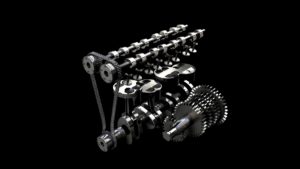
ProAdvise Car Advisors – Tech Review
Thabiso Malimela. 11/08/2017
In the previous article (Part 1) we covered perhaps the most emotive part of a car, the engine, and then we also explained why a car has a certain number of gears in the drivetrain section. In this article we will be discussing the final three of the five sections that are essential to a car: The Chassis, Suspension and Wheels and Tires. Coming up next is a list of these sections and a comprehensive explanation as to what they are and what function they serve to the car:
The Chassis
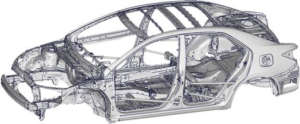
- This is what the chassis of a modern road car looks like – this on is called a unibody (chassis and body are one) and belongs to the 2014 Toyota Corolla
This may sound a little off topic but please just bear with me. How do you describe the colour blue to a man (or woman – sexism must fall) who’s been blind all his life? One would face the same problem when trying to explain what a chassis is – many people have never seen one. And in case you were wondering, it’s pronounced “sha-see” and also rhymes with “batty”. So what is a chassis? A chassis is like the skeleton or foundation of a car and like the two examples mentioned, ever part of the car is attached to the chassis, except the wheels and brakes, but more about that later. So why is the chassis important? Well, it may be a static part of the car but there’s a lot of things that the chassis experiences that we can’t see.
Like the foundation of a house or your skeleton, the chassis has to bear all the loads induced when a car accelerates, brakes or changes direction and in most extreme cases, is involved in an accident. Yes, the difference between a safe car and a death trap is the construction of its chassis. In fear of making this too complex, I will keep away from the details of engineering mechanics but basically, a safe vehicle will have a chassis that absorbs the force of the impact and deflects it away from the passenger compartment – where you and bae seated. So simply, a softer and more flexible chassis would be preferable. The problem with a soft and flexible chassis is that it has a great impact on the handling of the vehicle. Imagine that your whole car was made out of jelly – you’ll probably crash it before you can argue “Wait, is that even possible?” Furthermore, a car with a very stiff chassis would handle like a sir but all of the crash impact would be transferred directly to your face – not good for love life then. So manufacturers will have a mixture of both – they will usually use a stiff chassis for good handling but integrate crumple zones to absorb the energy of the crash. You see? They DO care about your face.
However, a car with a damaged chassis (bent or contorted even slightly) will be deemed beyond repairs because, especially with modern cars, the chassis and the body are made to be one in the same and this makes it complex and thus expensive to repair. Even in cases where it is possible to straighten out the chassis again, can you be sure enough that it hasn’t compromised the safety of your car? This is why insurance companies will be quick to right off a car when they find out the chassis has been damaged. Common incidents where a chassis is damaged is when you roll your car and the roof structure bends, front collisions though these may depend on speed and angle of the impact, and side impacts, especially right between the front and rear door.
The Suspension
This part of the car can be compared to your legs, whether or not you skip leg day. When you’re running from the police or, even worse, an angry dog and you jump over a tall fence – when you land on the other side, what would happen if you didn’t allow your knees to bend as you landed? I know: hospital and some crutches. So like a person jumping a fence, a car needs something to absorb the vertical load of its weight when it experiences an uneven surface. Part of this load is absorbed by the tyres, but mostly it is the suspension that takes the brunt of the beating. The suspension’s primary job is to absorb the vertical loads and keep the tyres in contact with the road and this has a diaspora of consequential benefits, the main being ride comfort and predictable vehicle handling. The two topic-worthy parts of the suspension is the Springs and the Shock Absorbers (or Dampers).
- Shock Absorber (or Dampers)
A shock absorber’s job is to absorb or dampen the force of the cars weight shift. If a car didn’t have shock absorbers, it would ideally bounce up and down endlessly like a rubber ball every time it hits a speed hump – I doubt that would be comfortable at all and God help you if you have motion sickness. There are different types of dampers or shock absorbers and their differences lie in the way they dissipate the shock load. Most cars use Nitrogen and oil filled shock absorbers and my Ferrari driving peeps will have magnetic dampers (MagneRide) that uses a magnetic (magnetorheological) fluid that can change its viscosity (thickness) at the switch of a button. Fancy, I know!
For understanding sake, I’ll focus on the regular gas and oil filled shock absorber. The shock absorber has two halves – one that connects to the chassis of the car, and the lower half to the wheel assembly. When you hit a bump, the wheel moves up with a force and since the shock absorber is connected to the wheel assembly, it moves up too. Inside the shock absorber there’s a piston with perforations on its face and this allows the oil (pushed up by the force) to pass through these holes but it can only pass through at a certain speed depending on the size of the hole (the fluid will pass slower through smaller holes). This resistance to fluid flow does work against the force of the wheel and that energy is dispersed as heat. The Nitrogen gas keeps this oil under pressure so that it doesn’t create foam and limit its dampening abilities. The hissing sound you hear when a car hits a bump is normal and is just the sound of gas and oil moving around to make your car ride like a Rolls Royce.
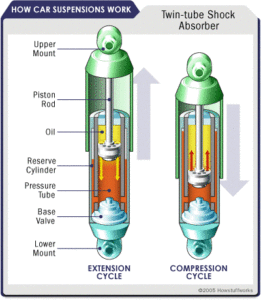
- The diagram above shows the two stages of a shock absorber and how they absorb the energy of the shock load.
- The Springs
I’m sure everybody knows what a spring is and how it works. The coil springs found in a car do the same job, except now, its sole purpose is to force the shock absorber back into its original position, which would mean the shock absorber going in the opposite direction as it was when it was being compressed. Consequently, the spring length and hardness also determine the car’s ride height. Usually the spring would be wrapped around the shock absorber in a combination called a coilover. There are many types of springs you can find out there, with the coil spring being the most common. You also get leaf springs which are those long and narrow plates you’ll find on the inside of the rear wheels in small trucks or buses. There’s also a much more complex and expensive air suspension setup that replaces the coil spring with some airbags but those tend to leak and you find your car literally on its belly – that was for you Mercedes CLS owners.
Warning: If you want to drop the ride height of your car, do not cut your springs or fit them with compressing clamps. Rather buy a set of lowering springs or better yet, buy a pair of shock absorbers that match the lowering springs and if you’ve got money lying around, buy yourself a set of fully adjustable coilovers.
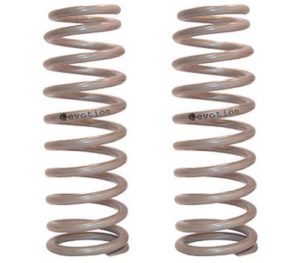
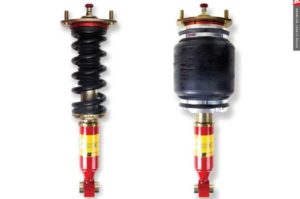
- (left picture) A coil spring removed from the strut
- (right picture) On the left is a coilover. Notice how the spring and damper are in combination. The right piece is an air suspension strut. Instead of a spring, it has an airbag or air spring.
The Brakes and Tyres
Most people don’t realise it but the brakes and tyres are the most important parts of a car – the suspension is a close second. But why so? Well, technically, your car is only as good as its brake and tyres. Okay I’ll try again: why do you think the guys at Formula 1 put so much emphasis on these two aspects (except aerodynamics and suspension setup)? This is because they know that these are the parts of the car that could mean the difference between winning and losing. To them, braking later and having the most amount of grip is more important than having the most powerful engine. However for us who’s last names are not Schumacher, brakes and tyres represent a huge safety aspect.
- The Brakes
The brakes, as we all know, is the system that allows the car to reduce its speed and eventually come to a stop. The way they do this is actually pretty simple. The braking system of a car consists of the following parts: the brake discs (that shiny circular thingy inside the wheel), brake pads, brake caliper, brake master cylinder, brake fluid reservoir and of course, the brake pedal. When you press the brake pedal, the brake master cylinder boosts the force of your foot on the pedal to give enough braking force. The brake fluid, flowing at a boosted pressure from the brake master cylinder, flows to the brake caliper where it forces a piston outward. The cylinder, because of the force, pushes on the brake caliper which in turn presses onto the brake pad. The brake pad, which is separated from the spinning brake disc only by a few millimetres then squeezes onto the brake disc and the resulting friction slows the car down.
The thing to know about brakes is that they are temperature sensitive – they operate best within a certain temperature range. When they’re too cold or too hot, they won’t be effective as they should be. Excessive braking causes the brake disc, pad and brake fluid to overheat and thus retarding braking – this is called brake fade. You should also cool your brakes down before parking your car if you’ve been doing some “irresponsible driving” otherwise the brake discs will warp and there’ll be some vibrations when you brake.
Just like every product out there, there are cheap and there are expensive brakes and usually you can justify the price. Cheap brake pads usually have a high metallic content and will make a high pitched squealing sounds when the brakes are applied. Their performance is poor but they may last longer due to their hardness. While expensive brakes are excellent performers, you must remember that they are still expensive! And sooner or later, you’re going to have to replace them. So when replacing brake pads and discs, don’t be too creative – stick with the manufacturer’s specification. Also, make sure your brake fluid is replaced and bleeded or flushed every time you fit new brake pads to get rid on any air bubbles in the brake lines.
Warning: Do not let brake fluid come into contact with your car’s bodywork as it will damage the paintwork.
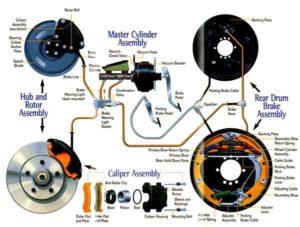
- A complete diagram of all the components that fall under the braking system. Some cars will use drum brake in the rear and others will use disc brakes and brake pads.
- The Tyres
I must remind you that the only contact your car has with the road is four coin-sized points on the tyre. Therefore the difference between safety and potential death could be down to these four points. Like the brakes, tyres are also temperature sensitive, but their performance is dependent on other factors too: tyre pressure, tyre compound (the properties of the rubber) and tread. The wrong combinations of these could greatly compromise your safety. For road use, temperature is not a huge factor because the manufacturer made provisions for a wide range of temperatures (except snow – they have winter tyres for that!). However, temperature does have a huge effect on tyre pressure.
Between the rim and the tyre, there is air (surprise, the tyre is hollow). This layer of air under pressure also helps absorb bumps on the road. As we know, air has the ability to expand and contract. When your tyres are pumped to a certain pressure, this pressure can rise as the tyre temperature rises when the road surface is hot – assume it is summer and it’s a sunny day. When the temperature cools, this pressure will drop too, so try and check the tyre pressures at normal temperatures and not extreme highs or lows. To maintain constant tyre pressures, fill your tyres with Nitrogen gas as it is less sensitive to temperature change. And what effect does tyre pressure have on tyre wear? Well, the lower your tyre pressure, the more rubber you’ll have in contact with the road and while you will have more grip (remember, grip is friction), your tyres will be eaten away faster because of the increase in friction. However, if you increase the tyre pressure, less rubber will be in contact with the road and you’ll have less grip but with the decrease in friction, tyre wear will also decrease.
And this relates to tyre compound as well since the compound of the rubber of a tyre dictates how hard or soft the rubber can be – hard rubber has less friction and soft rubber has more. Therefore, a softer compound tyre will wear out quicker than a harder compound tyre. If your car is fitted with soft compound tyres, it is suggested that you increase the tyre pressure. The opposite applies for hard compound users so that you slightly increase the grip. The amount of tyre pressure you put in your tyres will also depend on how much weight you’re carrying. If you’re riding solo, you can run low tyre pressures and be just fine. However if you’re carrying a full load or even pulling a heavy trailer, its best you pump up your tyres.
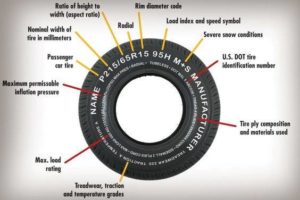
- A complete guide to what the letters and numbers on the tyre wall mean. You will need to know the tyre dimensions when purchasing a matching tyre. Notice how they spell tyre as “tire”. You gotta love the Americans!
The grooved lines (called tread) you see on a tyre are there to remove standing water between the tyre and the road when the road is wet– that’s why water sprays away from a tyre when it rains. When you start to see the grooves disappear, it’s time for you to visit your nearest tyre dealer. Driving with worn tyres would cause your car to literally float (called aquaplaning) in the rain water in which case we’ll be hearing about your little episode on radio traffic reports.
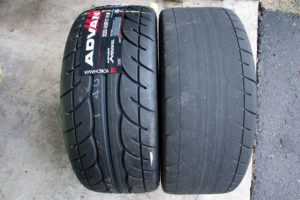
- Fresh tyre (left) vs worn down tyre(right) If your tyres look anything like the one on the right, it’s time for a new set – we wouldn’t want anything bad to happen to you.
How much control you have over the car will depend heavily on how much grip you have. And your only source of grip is that from the tyres. With more grip, your brakes are therefore more effective and your stopping distance will be good while having less possibility of locking your wheels (if your car doesn’t have ABS fitted). However, there is such a thing as too much of a good thing. Too much grip will increase tyre wear and it will increase fuel consumption too. That is why it is recommended that you run with the prescribed tyre pressures and these are usually found on the inside of the fuel cap or on the inside of the door.
Warning: Do not buy retreaded tyres – these are not safe and if your insurance finds out you had them fitted, they could reject your claim. Your insurance can also reject your claim if they find out that your tyres were below minimum tread depth.
Fun Fact: Tyre smoke is not actually smoke. It’s steam that arises when the tyre is heated to a point where the water molecules within the rubber begin to evaporate.
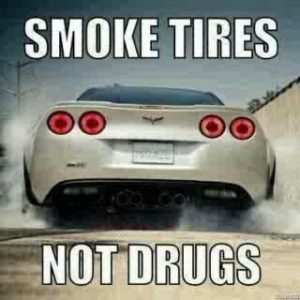
To summarise the content of this article and the previous one, consider this:
The suspension, brakes and tyres prevent you from crashing, while the chassis makes sure that when you do crash, you can survive the wreck and not emerge looking like a zombie. The engine and drivetrain, as far as I can see, are there to make sure that the government can make money from speeding tickets and to actually get you to work – so two things one might not like. However when all these components come together as an expensive unit, you can’t help but be influenced in ways that no other machine has ever before, so much so that it has even spawned a culture of its own – actually, it explains why I even write this stuff!
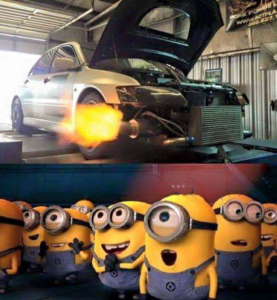
This article was brought to you by:
ProAdvise Car Advisors
Giving you only the best automotive and car buying advice!
Looking for a car? We’ll help you find the best one!

